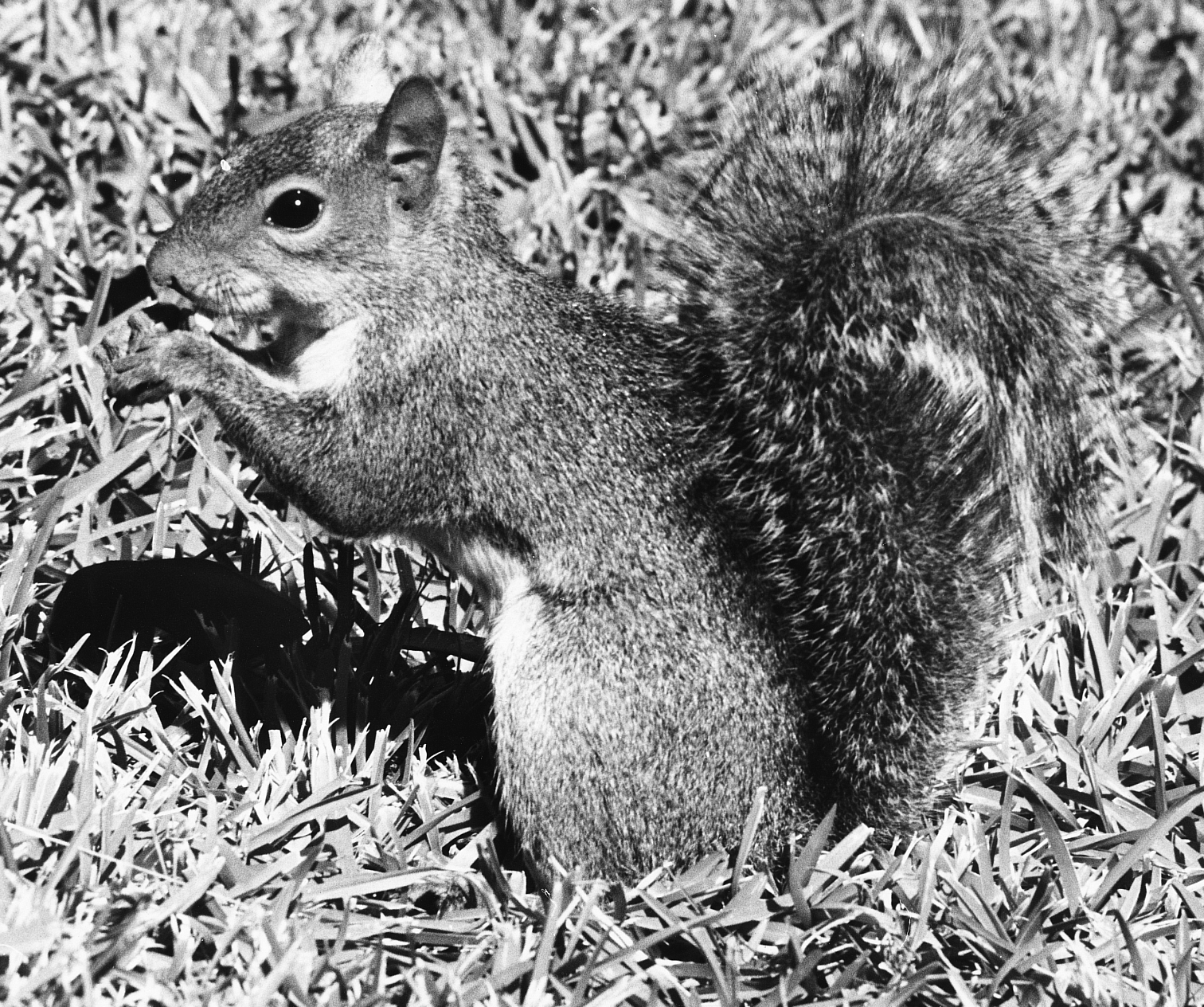EASTERN GRAY SQUIRREL
Sciurus carolinensis Gmelin 1788
Order Rodentia : Family Sciuridae
DESCRIPTION. A medium-sized squirrel with upperparts grayish to dark yellowish rusty, especially on head and back; legs, arms, sides of neck, and sides of rump with gray-tipped or white-tipped hairs, giving a gray tone to these parts; hairs of tail dull yellow at base, then blackish, and tipped with white; underparts white; ears with conspicuous white spot at base in winter. Dental formula: I 1/1, C 0/0, Pm 2/1, M 3/3 × 2 = 22. Averages for external measurements: total length, 460 mm; tail, 210 mm; hind foot, 61 mm. Weight of adults, 321–590 g.

DISTRIBUTION. Native distribution includes eastern one-third of state. Introduced at locations to the west of its native range. For example, a thriving population was established in the city of Lubbock in the 1970s, over 600 km (373 mi.) from the species' normal range.

SUBSPECIES. Sciurus c. carolinensis.
HABITS. In Texas, eastern gray squirrels, or cat squirrels, live mainly in dense groves of live oak and water oak and in the deep swamps of cypress, black gum, and magnolia that border the streams. In 1967 Phil Goodrum found that they were most abundant in hammocks where the principal vegetation was white oak and water oak mixed with magnolia, linden, sweet gum, and holly. Poorly drained bottomlands, with their pin, evergreen, and overcup oaks, elms, bitter pecan, black gum, cypress, and ash, support much smaller populations. In well-drained bottomlands, with post and red oaks, hackberries, gum elastic, and pecan, the populations are still smaller, and upland forests usually are devoid of gray squirrels.
Eastern gray squirrels den in hollow trees when available, but they also utilize outside leaf nests, especially in spring and summer. Leaf nests are built in trees and are constructed of twigs, leaves, and so forth on the outside and lined with shredded bark, plant fibers, grasses, and occasionally discarded paper. Usually there are two openings to a leaf nest. They serve usually as refuges, resting and feeding stations, and occasionally as nurseries.
Gray squirrels feed on a variety of foods. Goodrum lists buds and mast of oak and pecan trees, grapes, fungi, red haw buds, sedges, grasses, mulberry, larval and adult insects, and amphibians. Several reports indicate that gray squirrels consume bird eggs and nestlings, especially in the early spring; their major food source, however, is mast (e.g., acorns). They begin eating acorns in the spring and continue throughout the year if they are available. When mast crops fail in one area, the gray squirrels usually move en masse to other areas where food is more abundant. This accounts in large measure for the migrations of squirrels that are frequently reported. Normally they feed twice a day (early morning and late afternoon) and are less active at midday.
Gray squirrels breed throughout the year, but there are two rather distinct peaks, in July–September and again in December–February. Mating is more or less promiscuous; several males usually attempt to mate with each receptive female. After a gestation period of 40–45 days, the two to four naked, blind, and helpless young are born. They remain in the nest for about 6 weeks, by which time their eyes are open and their teeth have developed so that they can eat solid foods. By that time they weigh about 200 g. They remain in family groups for a month or so after they begin foraging for themselves. When 6 months old they are nearly adult in size and have left the home territory. They mature sexually in their first year and produce young of their own when about 12 months old.
In the last century, these squirrels were highly prized as game and a food source. They do some damage in pecan orchards, but such depredations are local in nature and can usually be minimized by placing tin shields around the trunks to prevent the squirrels from climbing trees. At times, they have been documented to cause power outages by chewing through electric lines.
POPULATION STATUS. Common. The eastern gray squirrel is locally common in parts of east and central Texas, especially in urban areas. They have been introduced into many cities across the state.
CONSERVATION STATUS. The IUCN recognizes the eastern gray squirrel as a species of least concern, and it does not appear on the federal or state lists of concerned species. The most serious conservation problems with squirrels in Texas are associated with the gray squirrel. A drastic reduction in suitable habitat occurred throughout the twentieth century as a result of detrimental land-use practices, such as logging hardwoods, employing certain practices of timber stand improvement, establishing pine plantations, overgrazing domestic livestock, flooding bottomland habitats through reservoir impoundments on major streams and rivers, and draining lowland bottomlands. Their future will depend on the acreage remaining in hardwood forests, the lengths of timber rotations, the species composition of hardwood stands, and the abundance of mast supplies and dens. However, in several areas these squirrels have adapted to urban areas and appear to be doing quite well.
REMARKS. Recently, the aforementioned population that was introduced into the Lubbock area has developed a pelage polymorphism. These squirrels have an orangish-red tail that is increasing in frequency throughout the population.
From The Mammals of Texas, Seventh Edition by David J. Schmidly and Robert D. Bradley, copyright © 1994, 2004, 2016. Courtesy of the University of Texas Press.
Natural Science Research Laboratory
-
Address
Museum of Texas Tech University, 3301 4th street, Lubbock, TX 79409 -
Phone
806.742.2486 -
Email
nsrl.museum@ttu.edu

